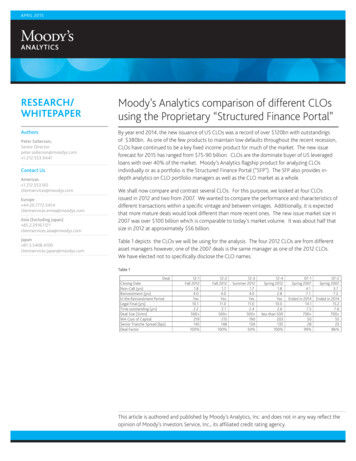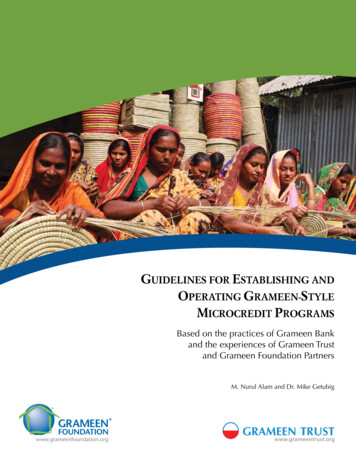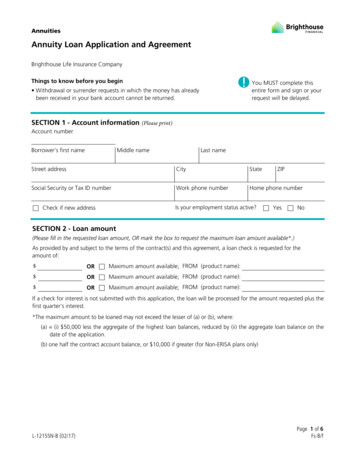
Transcription
The NAIC’s Capital Markets Bureau monitors developments in the capital markets globally and analyzes theirpotential impact on the investment portfolios of U.S. insurance companies. Please see the Capital Markets Bureauwebsite at INDEX.Collateralized Loan Obligations (CLOs) PrimerAnalyst: Jennifer JohnsonExecutive Summary CLOs are structured finance securities collateralized predominantly by a pool ofbelow investment grade, first lien, senior secured, syndicated bank loans, withsmaller allocations to other types of investments such as middle market loansand second lien loans.CLO debt issued to investors consists of several tranches, or layers, with differentpayment priorities and, in turn, differing credit quality and credit ratings.The senior-most tranche is the most-protected and, therefore, has the highestcredit quality and the lowest coupon.CLOs have structural features that serve as protection for the debt and equityinvestors, such as overcollateralization and interest coverage tests.Due in part to sound structural features, a low default rate environment for bankloans and prudent investment management, CLOs were considered “survivors” ofthe financial crisis.While they are historically less than 1% of total U.S. insurer cash and investedassets, CLOs offer an attractive yield alternative to traditional bond investments.Brief Background on CLOs, CBOs and CDOsThe structured finance securities market not only includes CLOs, but also collateralized bond obligations(CBOs) and collateralized debt obligations (CDOs). Note that since the financial crisis, CLOs havecontinued with new issuance, while CBOs and CDOs have almost disappeared. CBOs are structuredfinance securities that are collateralized by a pool of bonds, often high-yield corporate bonds,investment grade bonds, or emerging market sovereign and/or corporate bonds. CDOs includetransactions that are collateralized by trust preferred securities (TruPS CDOs), asset-backed securities
(ABS CDOs), commercial real estate/commercial-mortgage backed securities (CRE/CMBS CDOs),residential-mortgage backed securities (RMBS CDOs), and even other CDOs or CLOs (CDO-squareds). Asdiscussed in this primer, CLOs are collateralized by broadly syndicated bank loans (BSLs), as well asmiddle market loans. For all aforementioned CLOs, CBOs and CDOs, principal and interest incomeearned on the underlying pool of assets is used to pay periodic interest to investors (most often, semiannually or quarterly) and principal when due at maturity (on average, 10 years). The first CBO and CLOwere brought to market in the late 1980s, and as the market evolved, CDOs began to appear.Unlike CLOs, CDOs and CBOs had shown to be volatile asset types during the recent financial crisis. Thiswas due in part to the volatility of the underlying commercial and residential mortgage loans. Inparticular, RMBS CDOs had undergone severe and multiple ratings downgrades by the three majornationally recognized statistical ratings organizations (NRSROs)—Standard & Poor’s Global Ratings, FitchRatings and Moody’s Investors Service—due to the negative impact of delinquent, defaulted andforeclosed residential mortgage loans held in the underlying RMBS pools, especially those containingsubprime and adjustable rate mortgages. CLOs, however, did not experience this trend, due in part tothe underlying bank loans and the ability of the capital structure to withstand certain structuralperformance measures (relative to credit enhancement levels and interest coverage). As a result, CLOswere deemed the “survivors” of the financial crisis.The Composition of a CLO Capital StructureChart 1 shows the capital structure of an arbitrage CLO transaction. Investor proceeds are used topurchase a portfolio of leveraged bank loans, whose principal and interest are used to pay debt serviceto the noteholders, with any remaining amounts paid out to the equity investors. The transaction isreferred to as “arbitrage” because it aims to capture the excess spread between the portfolio ofleveraged bank loans (assets) and classes of CLO debt (liabilities), with the equity investors receiving anyexcess cash flows after the debt investors are paid in full. Arbitrage CLOs account for 90-95% of CLOtransactions. The CLO is structured as a special-purpose vehicle (SPV), and sometimes the CLO manageris an equity holder. However, this is not always the case, and it is not a requirement.Chart 1:2
About 5-10% of CLO transactions include “balance sheet” CLOs, whereby the mechanics are the same asarbitrage CLOs, but they differ in that balance sheet CLOs are structured primarily as a funding sourcefor the issuer (usually a bank or specialty finance company). With balance sheet CLOs, the issuersecuritizes the bank loans (middle market or broadly syndicated) off its balance sheet into an SPV, forthe purpose of raising capital, and it typically retains the equity tranche.Whether arbitrage or balance sheet, the CLO capital structure is comprised of CLO tranches (or CLOdebt) plus an equity tranche, which serves as the first loss position. The tranches range from senior tosubordinated; the more subordinated the bonds, the lower the credit quality, and the more requiredcredit enhancement (i.e., the ratio of the principal value of the collateral to the principal value of theCLO debt). As such, senior tranches are rated higher (investment grade) than subordinated tranches(below investment grade) by the NRSROs, such as Standard & Poor’s and Moody’s Investors Service. Theequity tranche is typically unrated. Principal and interest on the CLO debt and returns to equity holdersare paid in accordance with “waterfall” instructions that are included in legal documents, such as thetrust indenture.CLO tranches tend to offer a higher spread for comparable credit risk, as they are typically priced at aspread (in basis points) above the three-month London Interbank Offered Rate (LIBOR). The CLOstructure also benefits from certain structural features such as credit enhancement. To ensure sufficientcredit enhancement supports the transaction, the CLO capital structure is subject toovercollateralization (O/C) tests at each tranche level, whereby the principal value of the underlyingportfolio must be greater than the principal value of the outstanding tranches. In addition, to ensuresufficient funds are generated by the underlying portfolio for timely interest payments to bond holders,the CLO structure is also subject to another structural feature in the form of an interest coverage (I/C)ratio, whereby the income generated by the pool of assets is compared to (and must be greater than)the interest due on the outstanding debt.Assets That Comprise the Underlying CLO Portfolio – Leveraged Bank LoansThe credit risk of a CLO is dependent on the underlying assets within the portfolio. For “traditional”CLOs, the collateral pool primarily consists of below investment grade, first lien, senior secured broadlysyndicated bank loans (usually at least 90% of the total portfolio), and it may include a pre-determinedallowable portion of other asset types such as second lien bank loans (which are highly leveraged) andunsecured debt, as well as middle market loans. Some CLOs consist predominantly of middle marketloans as the underlying collateral.The average rating of the underlying collateral is typically about single-B, and the leveraged bank loansare typically floating rate, based on LIBOR. In addition, there is also an allowance for leveraged bankloans that are “covenant-lite,”—that is, those that do not have as many restrictions relative to theborrower’s debt-service ability as typical bank loans.Prior to the financial crisis, the underlying collateral securitizing a CLO might also include a portion(typically 5%–10% of the total portfolio) of high-yield corporate bonds and other structured financesecurities (such as asset-backed securities (ABS), residential mortgage-backed securities (RMBS),3
commercial mortgage-backed securities (CMBS) and other CLOs). Post-crisis, around 2010, a newvintage of CLOs emerged with structural changes that were intended to strengthen credit support,including a shortened reinvestment period (whereby the principal and interest proceeds from theunderlying bank loan portfolio would be reinvested into additional loans). Then around 2014, thecurrent vintage of CLOs began, which eliminated the “bucket” of high-yield corporate bonds that waspreviously allowed in the portfolio.For diversification purposes, CLOs are structured with specific investment limitations, such as issuer andindustry concentrations, which aim to protect investors from potential losses. For example, a CLO’sunderlying portfolio may consist of 100 or more issuers across several industries. There are also limits tothe total amount of CCC-rated investments that may be included in the underlying portfolio, which aretypically limited to 5%–7.5% of the total portfolio.What Are the Dynamics of a CLO Structure?CLOs are generally structured as cash flow (arbitrage) transactions, whereby income generated by theunderlying collateral (i.e., principal and interest on the bank loans) is used to pay debt service to thenoteholders and equity investors. In the early stages of structuring a CLO, bank loans are purchased bythe CLO manager and warehoused (usually for a period of three to six months) prior to the transaction’sclosing date. Upon closing, the transaction then has a ramp-up period during which time the CLOmanager purchases additional collateral to complete the portfolio. Thereafter, there is a reinvestmentperiod, which lasts anywhere from two to five years, whereby trading of the bank loans may occur. Thatis, during this time, the asset manager may purchase or sell bank loans to improve the portfolio’s creditquality. Sales activity is classified as either discretionary, credit risk (when an impaired asset is sold) orcredit improved (when an asset is sold at a premium). After the reinvestment period has ended, the CLOmanager uses proceeds from interest income on the bank loans, bank loan repayments and maturitiesto pay down the CLO debt in order of priority/seniority (known as the amortization period), anddistributes any remaining proceeds to the equity investors as their return.A CLO is also structured with a “non-call” period in the first two years of its life immediately followingthe closing date. After this period, the majority equity investor can call the deal (redeem it in full) if thetransaction achieves a particular yield spread, and the CLO debt holders can be paid back in full.Cash-flow distributions on payment dates (also known as the “waterfall”) begin with payments to thesenior-most CLO tranche, which receives the highest claim on the flow of funds, followed by payment tothe lower-rated tranches, in order of seniority. (See Chart 2.) In addition, on payment dates, thestructure must achieve performance-based tests, such as the aforementioned minimum O/C level foreach tranche layer, before funds flow through to make payment on the additional tranches. To “pass”the O/C test, the principal value of the underlying collateral must exceed the principal value of the CLOtranche by a predetermined minimum ratio. Failure to meet the minimum O/C level at any point in thecapital structure results in redirecting the flow of funds to achieve this level, taking away from makingpayment to lower-rated tranches. Any funds that remain at the end of the waterfall may be distributedto equity investors as a return on their investment.4
Chart 2:Source: FitchRatings, “The 2018 Annual Manual (U.S. Leveraged Finance Primer) – Leveraged Loans,” May 18, 2018With regard to the composition of CLO investors, they vary by tranche, as shown in Table 1. Investorswith the least risk-appetite tend to invest in the senior-most tranches, while those with a highertolerance for risk invest in the equity (first-loss) tranche. The majority of U.S. insurer CLO investmentsare in senior and mezzanine (middle) tranches.Table 1:5
CLO ManagersCLO managers are responsible for investment management decisions for the CLO’s underlying portfolio.As such, they must have the appropriate infrastructure in place to properly manage the transactions.This not only includes having seasoned portfolio managers and credit analysts as part of the team, butalso experienced operations professionals and appropriate data management systems in place.Therefore, a comprehensive assessment of a potential CLO manager’s infrastructure is essential forinvestor (i.e., insurer) review, in order to derive comfort with their ability and experience as a CLOmanager.Depending on size, a typical CLO manager will have one or more portfolio managers (sometimes theyare asset-type specific), credit analysts (who may be industry specialists or generalists) and operationsprofessionals. CLO managers may include affiliates of private equity firms, hedge funds, large financialinstitutions and banks, and insurance companies, too. CLO managers typically receive a seniormanagement fee as a percentage of the underlying portfolio of bank loans’ par value, as directed andprioritized in the aforementioned waterfall. In addition, CLO managers may receive a subordinatedmanagement fee (at a lesser percentage) after the senior debt holders have been paid, which is alsoconsidered an incentive fee for the managers to make prudent investment decisions for the benefit ofinvestors throughout the whole capital structure.In addition to thorough credit analysis of the CLO investment, reviewing the infrastructure of the CLOmanager is equally important for the investor. This “due diligence” is intended to help the investorascertain whether the CLO manager understands the mechanics of the CLO structure and the creditassessment of the underlying assets (leveraged bank loans), as well as to derive comfort that the CLOmanager is managing to investor interests (and not his/her own).With the increase in demand for CLOs in recent years, new CLO managers came into the market, takingadvantage of favorable economic conditions. Currently, the largest 30 CLO managers represent 60% ofCLO issuance, according to Fitch Ratings data. In 2017, nine new CLO managers entered the market(compared to four in 2016).6
CLO Managers and Dodd-Frank Risk-Retention RulesThe federal Dodd–Frank Wall Street Reform and Consumer Protection Act’s (Dodd-Frank) risk-retentionrules went into effect on Dec. 24, 2016, for ABS, CMBS, RMBS and similar securitizations. The rules aredesigned to prevent lenders from making risky loans, packaging them into bonds and leaving investorswith all of the losses if/when payment defaults begin to occur. The “skin in the game” rules are intendedto align interests between issuers and their investors. The rules came about after subprime mortgagebonds triggered significant losses for banks and investors during the 2008 financial crisis. Participants inthe CLO market were initially concerned that the risk-retention rule would limit total CLO issuance. In2014, CLO new issuance reached a record level of 124 billion; in 2017, it reached its second highestlevel at 117 billion, according to Thomson Reuters LPC. (See Appendix for historical annual U.S. CLOissuance.)Effective February 2018, a court ruling exempted traditional (BSL) CLOs from having to comply withDodd-Frank risk-retention rules whereby the CLO manager would have been required to retain at least5% interest in the total capital structure. The ruling is expected to benefit smaller CLO managers whowould otherwise have been challenged to comply with the requirement (as they may not have had theability to easily raise the large sums of capital needed to comply), and perhaps, they may have beenprohibited from issuing new CLO transactions. Note, however, that this exemption does not apply tomiddle-market CLOs as they are subject to the 5% risk retention rule.Advantage to Investing in CLOsBecause of the higher-yielding nature of the underlying leveraged bank loans, even after subtracting theCLO manager portfolio management fees and expenses, the net yield on CLO debt is still attractive tosome investors. And due in part to the relative value of CLOs compared to other structured financesecurities (such as ABS, RMBS and CMBS), or even corporate bonds, the consistent performance of theunderlying bank loans (in a relatively benign credit environment) combined with more stringent capitalstructures make CLOs an attractive investment opportunity for investors who have not previouslyparticipated in this market, or perhaps, who have participated only on a limited basis.Depending on investment strategy and philosophy, CLOs represent attractive investment options duringtimes when risk/reward opportunities may be challenging. Most CLO investments within the U.S.insurance industry are historically held by life companies.What Are the Risks?As with most investments, CLOs have credit risk—that is, risk that the underlying portfolio will not beable to generate sufficient cash flow to pay investors on a full and timely basis when principal and/orinterest payments are due. This potential payment default can be influenced by a few factors – one ofwhich is the leveraged bank loan market in general; that is, taking notice of any issuers and/or industriesthat are experiencing difficulties or challenges in the current environment as CLO managers are makinginvestment decisions. Default in payment on the leveraged bank loans results in less cash for the7
underlying portfolio, and, in turn, less funds available to pay the CLO investors. For this reason, it isimportant that CLO portfolios are diversified by issuer and industry. If the leveraged bank loan marketexperiences difficulties, the liquidity of CLOs could also be negatively impacted.Prepayment risk may also arise as interest rates decrease and leveraged bank loan issuers refinance anyfloating rate loans, in turn reducing the underlying CLO portfolio principal value. CLO managers are thentasked with reinvesting the proceeds in new, economical (leveraged bank loan) opportunities.Conversely, as interest rates rise, borrowers may experience challenges making payments on theleveraged bank loans that comprise the underlying CLO portfolio resulting in delinquencies and ordefaults and, in turn, a lesser amount of cash flow would be available to pay the CLO investors. Notethat the CLO debt is typically floating rate as well, so interest owed to the CLO debt holders will alsoincrease as rates rise.Another factor is the experience of the CLO manager. This pertains not only relative to credit analysis,portfolio management, and necessary operations and administrative duties with regard to theunderlying leveraged bank loan portfolio, but also having experience with appropriately managing CLOstructures to the best interest of all investors.Maintaining adequate issuer diversification across the portfolio is also a potential risk factor worthnoting. CLO portfolios tend to have a certain amount of overlap across issuers given leveraged bank loanassets tend to be acquired in the primary market (new issues), and a large amount of overlap can occurwhen demand for bank loans outpaces supply. This trend is particularly evident across CLOs of the samevintage (year of origination) as well as with CLOs managed by the same asset manager. A highpercentage of overlap can indicate a highly correlated portfolio; correlation measures the likelihood ofdefaults occurring together.Statutory Accounting TreatmentAccording to the NAIC Accounting Practices and Procedures Manual, “loan-backed securities are definedas securitized assets not included in structured securities for which the payment of interest and/orprincipal is directly proportional to the payments received by the issuer from the underlying assets,including but not limited to pass-through securities, lease-backed securities, and equipment trustcertificates.” Loan-backed securities (LBASS) are issued by special-purpose corporations or trusts (issuer)established by a sponsoring organization. The assets securing the loan-backed obligation are acquired bythe issuer and pledged to an independent trustee until the issuer’s obligation has been fully satisfied.LBASS investors only have direct recourse to the issuer’s assets, but they may also have secondaryrecourse to third parties through insurance or guarantee for repayment of the obligation.For reporting and statutory accounting purposes, CLOs typically fall into the category of loan-backed andstructured securities (LBASS). If a CLO is defined as a LBASS, then it follows the guidance of Statement ofStatutory Accounting Principles (SSAP) No. 43R—Loan-Backed and Structured Securities. SSAP No. 43Rsecurities are reported on Schedule D-Part 1, and the measurement method for the investment dependson the reported NAIC designation. For U.S. insurers that maintain an asset valuation reserve (AVR), areserve to offset potential credit-related investment losses, CLOs that are LBASS “ shall be reported at8
amortized cost, except for those with an NAIC designation of 6, which shall be reported at the lower ofamortized cost or fair value.” For U.S. insurers that do not maintain an AVR, CLOs that are defined asLBASS are “ designated the highest-quality and high-quality (NAIC designations 1 and 2, respectively),shall be reported at amortized cost.” And CLOs that are defined as LBASS with NAIC designations 3through 6 “ shall be reported at the lower of amortized cost or fair value.”LBASS meet the definition of assets as defined in SSAP No. 4—Assets and Nonadmitted Assets and areadmitted assets to the extent they conform to the requirements of SSAP No. 43R.9
Appendix:10
Key TerminologyCollateralized Loan Obligation (CLO)Structured finance security collateralized predominantly by broadly syndicated, leveraged bank loans.Collateralized Bond Obligation (CBO)Structured finance security collateralized predominantly by bonds, particularly high-yield corporatebonds, investment grade corporate bonds, or emerging market sovereign and/or corporate bonds.Collateralized Debt Obligation (CDO)Structured finance security collateralized by trust preferred securities (TrUPS), asset-backed securities(ABS), residential mortgage-backed securities (RMBS), commercial real estate/commercial mortgagebacked securities (CRE/CMBS CDOs), or other CDOs or CLOs.Leveraged Bank LoansLoans by a group of lenders to companies that are typically rated below investment grade. The loans aretypically secured with a lien on the company’s assets and are generally senior to the company’s otherdebt.Broadly Syndicated Bank Loans (BSLs)As the largest segment of the leveraged bank loan market, BSLs are loans to companies with earningsbefore interest, taxes, depreciation and amortizations (EBITDA) over 100 million and with public creditratings from the rating agencies. They are usually senior secured bank loans originated in connectionwith merger and acquisition activity or leveraged buyouts. They are also usually floating rate based onLIBOR.Special Purpose Vehicle (or “SPV”)Trusts whose operations are limited to the acquisition and financing of specific assets into the pool thatcollateralizes the structured securities (in this case, CLOs); an SPV is the actual issuer of the CLOtranches.TrancheClass of debt within a securitization’s capital structure.Credit EnhancementAlso referred to as ‘overcollateralization’, it is the ratio of the aggregate principal value of pooled assetsto the outstanding debt (tranches) that comprises the capital structure.Interest Coverage Ratio11
Ratio of total interest income generated by the underlying pool of assets to the total interest due on thedebt (tranches) outstanding.Closing DateDate the underlying portfolio is fully ramped and coverage and quality tests begin to take effect.First Lien Bank LoanHighest priority debt in a company’s capital structure.Covenant-Lite (also known as “Cov-Lite”)Leveraged bank loans which do not have as many restrictions relative to the borrower’s debt-serviceability as typical bank loans.Middle Market LoanLoans to companies with less than or equal to 500 million in gross revenues and less than or equal to 50 million in EBITDA; they are usually floating rate based on LIBOR.CLO ManagerResponsible for credit analysis, portfolio management, operations and administration of the CLO. TheCLO manager selects the underlying assets for the CLO portfolio and has a fiduciary responsibility to thenoteholders and equityholders. Sometimes a CLO manager may be an investor in the CLO.Ramp-Up PeriodFollowing the closing date, the months following (anywhere from one to four months) during which theCLO manager purchases the remaining collateral for the bank loan portfolio.Effective DateDate on which the Ramp-Up Period ends and when the coverage tests begin to apply.Non-Call PeriodFirst two years of the transaction’s life where the bond holders receive a yield spread specified at closingand the bonds cannot be called.Reinvestment PeriodTwo- to five-year period during which the CLO manager is able to buy and sell collateral fordiscretionary, credit-impaired and credit-improved purposes. Investors do not receive principalpayments during this time. Maturing collateral and prepayments are reinvested in new collateral.Amortization Period12
Once the reinvestment period has ended, the CLO manager pays down the debt (tranches, or CLOliabilities) following the priory of payments included in the legal documents, using bank loanprepayments or proceeds from the sale of underlying assets.Dodd-Frank Wall Street Reform and Consumer Protection Act (Dodd-Frank Act)A U.S. federal law that places regulation of the financial industry in the hands of the government. Thelegislation, which was enacted in July 2010, created financial regulatory processes to limit risk byenforcing transparency and accountability.Credit RiskPossibility that a payment obligation will be missed, resulting in a loss; possibility of loss if a borrowerdefaults on making a loan payment.Prepayment RiskThe risk that a borrower will repay a loan before its maturity, depriving the lender of future interestpayments.Amortized CostAccumulated portion of the recorded cost of a fixed asset that has been charged to expense througheither depreciation or amortization.Asset Valuation Reserve (AVR)Capital required to be set aside in order to cover a company against unexpected debt. The assetvaluation reserve serves as a backup for equity and credit losses.13
Useful LinksPublished NAIC Capital Markets Bureau Special Reports on CLOs:U.S. Insurance Industry Exposure to Collateralized Loan Obligations & Market Trends, June 2014U.S. Insurance Industry CDO/CLO Update, June 2012Insurance Company CDO Exposure, Feb. 2011Published NAIC Capital Markets Market Buzz – LIBOR:The Rise in LIBOR14
is, during this time, the asset manager may purchase or sell bank loans to improve the portfolio [s credit quality. Sales activity is classified as either discretionary, credit risk (when an impaired asset is sold) or credit improved (when an asset is sold at a premium). After the reinvestment period has ended, the CLO










